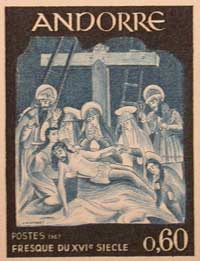|
|
Home | Blog | Crosses | History | Articles | About | Resources |
Articles This is a modern Andorre stamp showing the descent from a Tau cross, taken from a 16th century fresco at Maison des Vallees. The Tau cross has never been as common as either the Greek or Latin forms. Today, it is occasionally found as part of the logo for the Franciscans. The Tau (crux commissa) was one of forms used by the Romans for crucifixion. Others include trees, single poles (crux simplex), an X (crux decussata), and a structure like a football post that allowed the body to be hung by one hand and one foot. One of the last reported outbreaks of St. Anthony's Fire occurred in August 1951 in the French village of Pont-Saint-Esprit. About 200 people became mad, ran into the streets as if on fire or stayed writhing in agony in bed. They were treated with antibiotics. A less dramatic outbreak may have prompted the Salem witch trials. |
The Tau Part 2 Back to Part 1 > Tau: The Anticipatory CrossSt. Anthony and the AntoninesIn 1095 an order of Hospitalers of St. Antonite (Antonines) was founded by a French nobleman, Gaston, and his son in order to help sufferers of St. Anthony’s fire (ignis sacer), caused by eating rye flour contaminated with a mold. The sufferers experienced hallucinations, an incredible burning sensation in the limbs, and ultimately gangrene. Gaston’s son, Guerin, had been cured of this disease. He had a vision of "Anthony instructing him to plant a Tau, which quickly bears fruit and develops healing powers" and selected the tau as the symbol of the order. (5) 
St. Anthony Abbott (251-356), an Egyptian monk, is one of the founders of Christian monasticism. According to legend, he used a crutch that resembled a tau cross in his older years, which became a reference to his longevity. When he visited another monk and the crutch was placed outside of the cave, this meant that he was in communion with God and not to be disturbed.(6) The Antonines placed a blue tau cross on a black habit. A bell came to be associated with the order, due to the practice of placing a bell on their pigs. According to one explanation, the order was allowed to let their pigs run free and had a bell placed on them for identification. (7) Pig fat may have been used to reduce the inflammation of skin diseases. (8) A secondary explanation for the pig is that this animal represented the lustful thoughts and temptations that St. Anthony often had to fight. (9) Since St. Anthony’s fire inhibited circulation to the extremities and resulted in gangrene, the order became skilled in amputation. Paintings and prints from the middle ages show St. Anthony and numerous limbs hanging nearby. (10) In 1441, an Antonine confraternity was founded in England. They wore an amulet shaped as a tau cross with a bell underneath, which is seen in portraits around this period. Recently, several tau crosses have been found in England that are beautifully crafted with a crucifix and a hollow place for a relic. (11) A tau cross with a bell made of lead was also sold as a pilgrim’s souvenir. In 1777 the order joined with the Knights of Malta, which was later suppressed in 1798 during the French Revolution. St. FrancisThe tau cross is an important symbol to St. Francis and the Franciscans. In Rome, he stayed at the Antonine order where he may have first encountered the sign. Omer Englebert writes that the other influence was Pope Innocent III, who said the tau mark was the sign of his reform of the church. (12) The Pope explained that the tau was both the mark in Ezekiel and the true form of the cross on which Christ was crucified.
The pre-Reformation sect the Waldenses (the movement began 1170) also believed that Christ died on a T-shaped cross. (14) In Western art, one of the ways to differentiate the thieves from Christ was to not only show them incredibly contorted but to place them on a tau cross. After 1300, Christ is also shown on a tau cross.(15) In Corofin, Ireland, a tau cross carved out of limestone was used as a boundary mark. The cross has two faces on the top of the arms looking up into the sky, similar to the design sometimes found on the head of ivory crosiers. Similar landmark crosses are also reported in Roquepertuse in south-east France. Back to Part 1>Notes
Back to top |
| Home | Blog | Crosses | History | Articles | About | Resources |